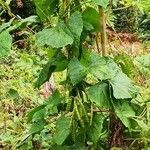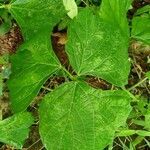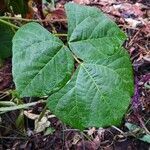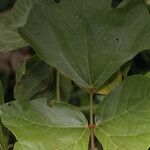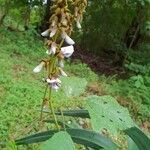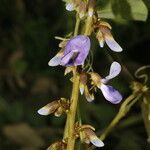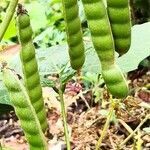Herbaceous vines; stems pilose, often drying hollow; rootstock tuberous. Leaves pinnate trifoliolate, the leaflets ovate to broadly ovate, the terminal leaflet broadest and often 3-7 lobed, the sinuses and lobes acute or rounded, mucronate, the lateral leaflets oblique, often less lobed or entire, basally deltoid, 3-veined from the base, drying slightly discolorous, glabrate or densely soft tomentose; petiolules 4-5 mm long, stout, pilose; petioles and rachis slender, drying angled, pubescent; stipels 1-2 mm long, acicular, sericeous, basally extended into definite ribs on the rachis; stipules minute, caducous. Inflorescences axillary pseudora-cemes, mostly 12-20 cm long, the flowers congested near the apex, the peduncle mostly longer and stouter than the petioles, the bracteoles resembling the stipels, subtending and much shorter than the calyx; pedicels ca. 2 per node, slender, ca. 5 mm long. Flowers blue, calyx 5-8 mm long, tubular, 2-lipped, the upper 2 teeth mostly connate, the lower 3 acute or acuminate, shorter than the tube, subequal or the lowermost longest and acuminate; standard ca. 15 mm long, suborbicular, emarginate, the wings and the keel about as long as the standard, sometimes ciliolate. Legume oblong, ca. 10 cm long, 1.5-2 cm wide, compressed, appressed strigose.
More
Vines, robust, twining. Root tubers 10-20 cm in diam. Leaflets rhombic or ovate, 4-18 × 4-20 cm, upper margin often somewhat dentate or lobed, lateral ones very oblique, sparsely pubescent abaxially. Racemes axillary, 15-30 cm; flowers 3-5 at thickened nodes. Calyx campanulate, 9-11 mm, adpressed pilose. Corolla purplish or pink; standard suborbicular, 15-20 mm, with yellow-green spot and 2 thickenings near base; wings falcate, auriculate; keel subfalcate, 15-20 mm. Ovary yellowish hirsute; style curved. Legumes 7.5-13 × 1.2-1.5 cm, compressed, hirsute. Seeds 8-10, subsquare. Fl. Aug, fr. Nov.
A climbing bean with hairy stems. It can grow up to 6 m tall. The stems are woody at the base. It has a white fleshed tuber. It has a rough sandy coloured skin. The leaves are alternate and made up of 3 leaflets. These leaflets have large teeth. The flowers are violet or white. The pod is 8-15 cm long, curved and hairy. The seeds are almost black. There are 8-11 seeds and they are flattened.
The young tuber is eaten either raw or cooked. They can be boiled, stir-fried, roasted, braised or used in soups. It can also be pickled. The tubers can be a source of starch used in custards and puddings. The young pods can be eaten. (They must be well cooked.) CAUTION Old pods and mature seeds can be poisonous.
